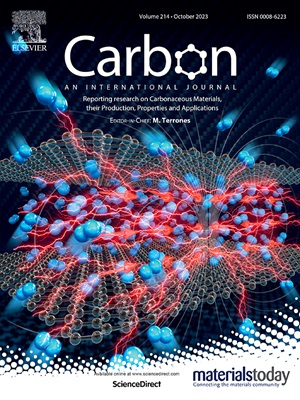In-situ growth of MoO2/MoS2 microspheres on reduced graphene oxide with enhanced dielectric polarization and impedance matching for boosting electromagnetic wave absorption
IF 10.5
2区 材料科学
Q1 CHEMISTRY, PHYSICAL
引用次数: 0
Abstract
Dielectric materials are promising candidates for electromagnetic wave (EMW) absorption due to the significant contribution of dielectric loss to EM energy dissipation. However, dielectric materials with single component usually exhibit limited EMW absorption performance because of their impedance mismatching and insufficient EMW attenuation capability. Reasonable designs of structure and composition are required to improve their EMW absorption performance. Herein, the rGO/MoO2/MoS2 (RMM) composite with MoO2/MoS2 heterogeneous microspheres grown in situ on reduced graphene oxide (rGO) is prepared through intermolecular hydrogen bonding and thermal reduction. The introduction of MoO2/MoS2 microspheres not only endows the composite with abundant mesopores and large specific surface area, but also facilitates the formation of heterogeneous interfaces and structural defects. By manipulating the relative component content of MoO2 and MoS2, RMM achieves excellent EMW absorption. At a relatively thin thickness of 1.70 mm, the reflection loss (RL) and effective absorption bandwidth of the composite reach −74.81 dB and 4.37 GHz. Correspondingly, the specific RL (RL/t) of the composite comes to −440.06 dB/cm, which is at the forefront among other typical dielectric microwave absorbers. This work provides a universal strategy to develop high-performance dielectric-type EMW absorption materials.

在还原氧化石墨烯上原位生长MoO2/MoS2微球,增强介质极化和阻抗匹配,提高电磁波吸收
由于介质损耗对电磁波能量耗散的重要贡献,介质材料是电磁波吸收的有希望的候选者。然而,单组分介质材料由于阻抗不匹配和EMW衰减能力不足,通常表现出有限的EMW吸收性能。为了提高其吸收EMW的性能,需要合理设计结构和组成。本文通过分子间氢键和热还原制备了在还原氧化石墨烯(rGO)上原位生长MoO2/MoS2非均相微球的rGO/MoO2/MoS2 (RMM)复合材料。MoO2/MoS2微球的引入不仅使复合材料具有丰富的介孔和较大的比表面积,而且有利于非均相界面和结构缺陷的形成。通过控制MoO2和MoS2的相对成分含量,RMM实现了优异的EMW吸收。在相对较薄的1.70 mm厚度下,复合材料的反射损耗(RL)和有效吸收带宽分别达到- 74.81 dB和4.37 GHz。相应的,复合材料的比RL (RL/t)达到- 440.06 dB/cm,在其他典型介质微波吸收材料中处于前列。这项工作为开发高性能介电型EMW吸收材料提供了一种通用策略。
本文章由计算机程序翻译,如有差异,请以英文原文为准。
求助全文
约1分钟内获得全文
求助全文
来源期刊

Carbon
工程技术-材料科学:综合
CiteScore
20.80
自引率
7.30%
发文量
0
审稿时长
23 days
期刊介绍:
The journal Carbon is an international multidisciplinary forum for communicating scientific advances in the field of carbon materials. It reports new findings related to the formation, structure, properties, behaviors, and technological applications of carbons. Carbons are a broad class of ordered or disordered solid phases composed primarily of elemental carbon, including but not limited to carbon black, carbon fibers and filaments, carbon nanotubes, diamond and diamond-like carbon, fullerenes, glassy carbon, graphite, graphene, graphene-oxide, porous carbons, pyrolytic carbon, and other sp2 and non-sp2 hybridized carbon systems. Carbon is the companion title to the open access journal Carbon Trends. Relevant application areas for carbon materials include biology and medicine, catalysis, electronic, optoelectronic, spintronic, high-frequency, and photonic devices, energy storage and conversion systems, environmental applications and water treatment, smart materials and systems, and structural and thermal applications.
 求助内容:
求助内容: 应助结果提醒方式:
应助结果提醒方式:


